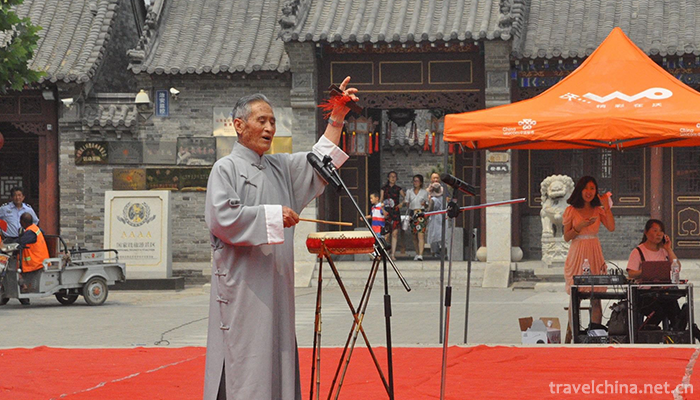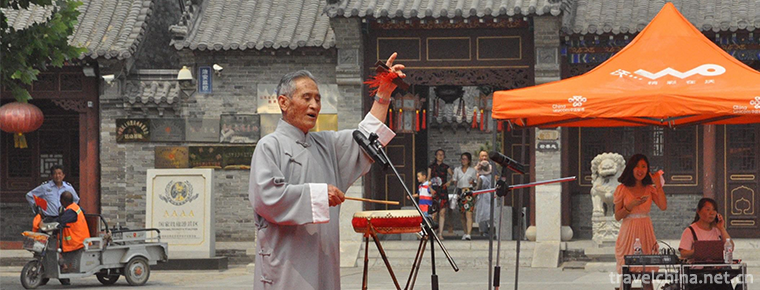Wooden drum
Wooden drum
Boardboard drum is a form of Quyi drum Book spread in most areas of Hebei Province. It has the nicknames of small mouth drum, clear mouth drum, timid drum, string drum and so on.
During the performance of the wooden drum, one person holds the wooden board in his left hand and the drum in his right hand, beating the wooden board and the book drum in turn in standing rap to match the rap, while another person holds the special accompaniment of three strings.
On May 20, 2006, the board drum was approved by the State Council of the People's Republic of China to be included in the first batch of national intangible cultural heritage list.
Historical Evolution
Origin and Background
Cangzhou wooden drum was produced in Cangxian folk. According to the historical records of the artistic population, Cangxian Chronicle and Cangxian Cultural Chronicle, Cangzhou wooden drum was bred and born in the middle and late Ming Dynasty.
Development
The early Qing Dynasty was widely spread in central Hebei Province. During Qianlong period, Cangzhou wood drum artist Li Chaocheng was called into the imperial palace to rap The Story of the Western Chamber, which was highly appreciated by the emperor. Ji Xiaolan mentioned Liu Junrui, a Cangzhou wooden drum artist, in his Notes on Yuewei Caotang, Jinyang Xiaoxia Lu. In the article, he called Liu Junrui, a Cangzhou guru, to make friends with strings. It can be seen that the wooden drum in Cangzhou was very popular at that time.
During the reign of Xianfeng and Tongzhi, Mr. Pang Fengyu carried forward Cangzhou's wooden boards.
In the early years of the Republic of China, Cangzhou wooden drum entered a prosperous period, and then gradually declined.
After 1949, Cangzhou Boardboard Drum Books entered the revival period, and the scope of activities gradually broadened. Later, in addition to Cangzhou, its footprint covered Beijing and Tianjin, northern Shandong, northeastern provinces and the Yellow River coast.
Artistic Characteristics
Singing Form
The singing form of the wooden drum is that the actor sings with his left hand holding the wooden board to beat the festival. The wooden board used is a small wooden board, and the right hand holding the drum. The drum is struck according to the singing needs. In the early period, another person used the middle three strings as accompaniment, and since the 20th century they have changed to the big three strings.
Singing characteristics
Cangzhou wooden drum music, there are three different types of plate structure: headboard, second board and third board. The singing tone is thick and rough, sometimes like singing and narrative, with a strong local flavor.
Melody characteristics
Early tunes were monotonous, accompanied only by three strings, and the performers hit the boards to master the rhythm. After the founding of the People's Republic of China, it absorbed Xihe Drum, Hebei Folk Songs, Opera and other tunes, and added Sihu and other accompaniment instruments.
Classic repertoire
The traditional programs of the wooden drum are very rich. The short stories include Mouse Advising Cat, Advising People, Du Lin Ying, Guo Ju Burying Er, Mulian Saving Mother and Zhao Wuniang. The middle stories include Erdumei, Xiangma Biography, Wusong Biography, Qianliju, Jinhuan Ji and Jiang Gong Case. The long stories include Zuo Zhuan Chun Chun Qiu, Wu Yue. "Spring and Autumn", "Heroic Spring and Autumn", "Walking Horse Spring and Autumn", "Golden Box Spring and Autumn" and "Five Spring and Autumn" and "Xue Jia Jiang", "Yang Jia Jiang", "Hujia Jiang", "Bao Gong Case", "Liu Gong Case", "Hai Gong Case" and other "three generals and three cases", as well as "Feilong Zhuan", "Ma Qianlong Gong Guo" and dozens of other.
Epidemic areas
Boardboard drum was originally a popular drum book in most rural areas of Hebei Province. It entered Beijing and Tianjin around 1870.
Inheritance and Protection
Current situation of circulation
Since the 21st century, the inheritance and development of wooden drum has been in a dilemma. There are only 8 well-known folk performers of wood drum, and the youngest is 57 years old. The prospect is very worrying.
protective measures
Beginning in 2007, Cangxian County of Hebei Province set up the Boardboard Drum Art Seminar to recruit small performers in the form of training classes. The old artists teach the skills of the Boardboard Drum, so that it can be inherited and developed.
Heritage figures
Tang Guifeng, male, was born in June 1939. The second batch of representative successors of national intangible cultural heritage projects, Cangxian County, Hebei Province, declared. Project name: Boardboard drum.
Liu Yinhe, male, was born in 1949. The second batch of representative successors of national intangible cultural heritage projects, Cangxian County, Hebei Province, declared. Project name: Boardboard drum.
Wang Zhenyi, male. The second batch of representative successors of national intangible cultural heritage projects, Cangxian County, Hebei Province, declared. Project name: Boardboard drum.
Selected as a non-survivor
On May 20, 2006, the board drum was approved by the State Council of the People's Republic of China to be included in the first batch of national intangible cultural heritage list.
The Value of Quyi
The singing music of the wooden drum is a kind of board music. Its melody is simple and unique, rough and thick. It has exerted different influences on the formation and development of many drum books and drums in the north, such as Xihe drum, Jingyun drum, Jingdong drum, Yue Ting drum and bamboo board writing, and has very unique artistic value.
Cangzhou wooden drum spread for hundreds of years, after several changes of the times, is a truly indigenous folk rap art. Its frustrating tragic tone is the embodiment of the voice of the people at the lower levels of society, which typically reflects "Yanzhao has been a generous tragic singer since ancient times". Cangzhou wooden drum not only has entertainment function, but also plays an irreplaceable role in various social and historical periods. Because it is easy to understand, strong emotional expression, strong local flavor, now compiled live singing publicity effect is good, in the vast rural areas, its popularity is no less than pop songs, television, movies.
social influence
Some experts said that "Cangzhou wooden drum is the mother root of Beijing rhyme drum". Gao Zhanxiang, the former Minister of Culture, pointed out that "Xihe drum was derived from the string book and wooden drum popular in the local area during the Qianlong reign of the Qing Dynasty." It can be said that without Cangzhou wooden drum, there would be no northern drum group. If we compare the northern drum group to a pyramid, then Cangzhou wooden drum is the pyramid base.
Important activities
From June 8 to 14, 2018, the National Non-Heritage Quyi Week was held in Tianjin. The wooden drum Jia Baoyu Night Exploration Xiaoxiang Pavilion, performed by Wang Yinjie and Zhao Fuyun, was displayed on the spot.


-
1.Crystal shrimp dumplings
Crystal shrimp dumpling is one of the traditional Cantonese tea house snacks. It is as famous as dry steamed cooking, fork cooking and egg tarts.
Time 2018-11-14 -
2.Mount QianQianshan Mountain
Mount Qian,Qianshan Mountain is located 17 kilometers southeast of Anshan City, Liaoning Province, with a total area of 44 square kilometers.
Time 2018-12-04 -
3.Nanxi Mountain Scenic Area Guilin
Guilin Nanxi Mountain Scenic Area (that is, Guilin Nanxi Mountain Park) is located in the south of Guilin City, about 1 kilometer north of the railway station. The two peaks of Nanxi Mountain confront
Time 2019-01-13 -
4.Yellow River Estuary Ecotourism Area
The Yellow River Estuary Ecotourism Area is located in the Yellow River estuary area of Dongying City, Shandong Province. It has unique ecotourism resources of the Yellow River Delta
Time 2019-01-18 -
5.Korean Agricultural Music and Dance
"Agricultural Music and Dance" is commonly known as "Agricultural Music", which is spread in the Korean community of Jilin Province, Heilongjiang Province, Liaoning Province
Time 2019-04-16 -
6.Ewenki Folk Songs
Ewenki folk songs are beautiful and beautiful, with unique style. People are improvised and sing improvised lyrics. Pastoral songs and hunting songs show the brave and simple
Time 2019-04-28 -
7.Luo Juan Opera
Luojuan opera, commonly known as trumpet opera, is one of the local operas and one of the national intangible cultural heritages spread in Runan County of Henan Province and Dengzhou City of Henan Pro
Time 2019-05-15 -
8.Mongolian embroidery
Mongolian embroidery is a kind of handicraft craft formed in the long-term production and life of the Mongolian people in China. Mongolian embroidery not only embroiders on soft fabrics, but also embr
Time 2019-06-03 -
9.Southern Drama
Nan Opera, also known as Nan Opera and Shi Nan Diao, commonly known as "Gaotai Opera" or "People's Congress Opera", is a local opera in Enshi Tujia and Miao Autonomous Prefecture o
Time 2019-06-07 -
10.Chengdu Normal University
Chengdu Teachers College is an undergraduate teacher's college in Sichuan Province, which is a pilot University for the overall transformation of Sichuan's comprehensive reform. The school's predecess
Time 2019-08-31 -
11.Suining hydrology
There are many small and medium-sized rivers in Suining City. There are 15 rivers with drainage area of more than 100 square kilometers in Suining City, including Fujiang River, Qiongjiang River, Qijiang River, Zijiang River, Qinggang River and Pengxi River.
Time 2020-12-16 -
12.Suining secondary industry
In 2019, the city's industrial added value will reach 49.158 billion yuan, an increase of 8.7%, contributing 50.7% to economic growth, and boosting economic growth by 4.1 percentage points. The number of Industrial Enterprises above Designated Size reached 573
Time 2020-12-16